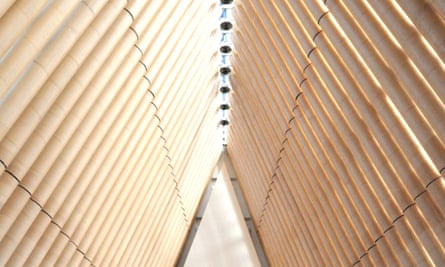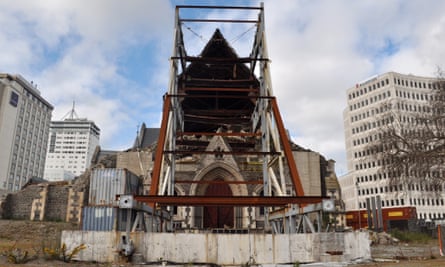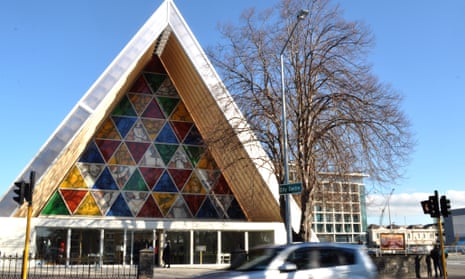Carolina Izzo runs her fingers over the edges of a coffee table. It is made from wood recycled out of the broken homes of Christchurch’s earthquake. “You can feel this has history,” the conservator says. “You can feel that time has imprinted on it. You cannot manufacture that.”
A short walk away sits the Christ Church Cathedral where time has imprinted a different feel. The front of the structure, completed 110 years ago, hangs open and loose like a broken jawed boxer. Steel support structures, raised in the aftermath of the 2011 earthquake, seem to support nothing. The building, once the epicentre of the city and its namesake, has sat unused and embroiled in legal battles. It is cordoned off, much of it hidden by large containers stacked up to protect the public in case of another shake.
But still it is a tourist attraction and still, for a different reason, likely Christchurch’s most photographed building. Once it housed concerts and meetings and, of course, religious ceremonies. Now it houses pigeons. “It was part of the city. It is even the symbol of the city council,” Izzo says. “What is Christchurch without its church?”
Izzo is charged with restoring the dome of the historic Isaac Royal Theatre – one of the few heritage buildings in in the city that is close to completion. Many others have been lost – either deemed too unsafe or too expensive to repair.
She was surprised to find that after the earthquake the Anglican Diocese wanted to “deconstruct” the cathedral rather than repair it. In its place the church envisages a modern building. But that decision has been met with legal challenges from those who see the cathedral’s place in Christchurch as representing more than just stone and mortar.
The Anglican diocese has already spent £2m on a new Transitional Cathedral which has been hailed by some as the most important building to be built in New Zealand for many years. “Internationally it is the most recognised building in the country,” says Andrew Barrie, professor of architecture at Auckland University. Due to its building materials the structure has become known as the “cardboard cathedral”. It was created by Shigeru Ban who this year won architecture’s grandest award – the Pritzker Prize.
Part of the importance of the Transitional Cathedral, Barrie says, was that it is the first non commercial structure to be built in the city centre after the earthquakes. The rebuild of Christchurch is slow with the dominant feature being piles of rubble and empty lots rather than gleaming new buildings. Barrie believes the Transitional Cathedral shows that amid all the bureaucracy associated with recreating a city, progress is being made.
He says the ruined cathedral has come to represent the earthquake itself: “The cardboard cathedral is a symbol of moving on.” So while a fully intact stone cathedral still remains on the city council’s letter head and the top image in a Google search, there are signs of a city doing just that. When visitors to Christchurch get a tourist map, for example, the cover of it features a newer vision – a cathedral made of cardboard.

On a recent Saturday afternoon the New Zealand Youth Choir was busy rehearsing for an evening performance at the front of the new cathedral. Tourists from myriad countries all filed into the lobby and respectfully took photos of its interior from a distance. An attendant welcomed them in. “Feel free to wander around.”
In its guest book, visitors wrote to theme. “Wow,” read a message from an Australian family. “One of a kind, lovely to be here.” The Sullivans from Tunbridge Wells in England said it was “inspiring”: “Something so beautiful to come from the ruins.” Bev from Auckland simply wrote: “Acknowledge your resilience.”
The cathedral has elements of wood, steel and poly-carbonate and is built to 130% of the current earthquake standard. It is designed to last for 50 years – it was never meant to be permanent. Barrie says it also shows how such structures can be a model of what is possible in post-disaster environments. “It was one of the first things that Christchurch could point to and say ‘we are rebuilding’.”
However, some would rather see the original Christ Church Cathedral restored, not only to honour its architectural significance but also its place in the founding of the city. The provincial council in the 1850s gifted the land to the church to build a city around. British architect Sir George Gilbert Scott, who later built St Pancras railway station in London, was enlisted to design it. It remains his only cathedral in Australasia. Others see the building as a vision of the past and representative of the trauma of the earthquakes.
Even the Archbishop of Canterbury, Justin Welby, has weighed in on the restoration debate, saying Christchurch should not cling to history. He urged the city to not “be boring” and suggested instead following Coventry Cathedral’s example of incorporating historic ruins into a new building.
Most simply want a decision to be made, because more than three and a half years later nothing seems to have been done. That responsibility remains with the Anglican diocese who own the building. Its bishop in Christchurch appears to have her eyes set on the future. The main purpose of the building is not for civic or heritage purposes, the church has said, it is to reveal and tell of God.
“Make no mistake,” says New Zealand’s former deputy prime minister, Jim Anderton. “This is not just a religious building. It is a civic building in every sense of the word.” Anderton was lured out of retirement by the Great Christchurch Building Trust on the promise that he could help save a key part of the city’s heritage. “I have seen what happens when you don’t look after heritage. You lose more than just buildings, you lose a city’s soul.”

A few months ago Anderton and a photographer flew over the cathedral in a helicopter, capturing the more intact – and seldom seen – parts of the building. Those photos have become the forefront of a campaign to try and reinvigorate public opinion and convince the diocese to change its mind.
Key to the argument is money. The Anglican diocese has estimated the restoration would cost between £53m and £112m, while the Great Christchurch Building Trust puts the figure at about £34m.
Anderton says the diocese received about £20m in an insurance payout for the cathedral so the shortfall is not much. “We could raise that in a weekend,” he says. “There are people out there with the means who want to see it rebuilt.”
Among those to lend support are British billionaire Hamish Ogston, who pledged £2m, and London-based New Zealander Euan Harkness. Harkness, the vice-chairman of Barclays Capital, put up the money to commission architects and designers to create an alternate idea – a “living cathedral” that would rival bold visions like the Sydney Opera House or the Sagrada Familia in Barcelona. The wreckage of the cathedral would be housed under a floating timber canopy that all residents could enjoy. The Anglican Diocese rejected the idea.
In the aftermath of the quakes the cathedral was issued with a notice by the Canterbury Earthquake Recovery Authority that meant, because of safety issues, the building could be deconstructed without having to go through the usual consent processes. After a challenge from the Great Christchurch Building Trust, referring to an act of parliament protecting church buildings, a judge ordered a stay on deconstruction until the church committed to build a cathedral, of any design.
“What’s clear is that if we had not done that, the cathedral would be gone,” says Anderton.

Comments (…)
Sign in or create your Guardian account to join the discussion